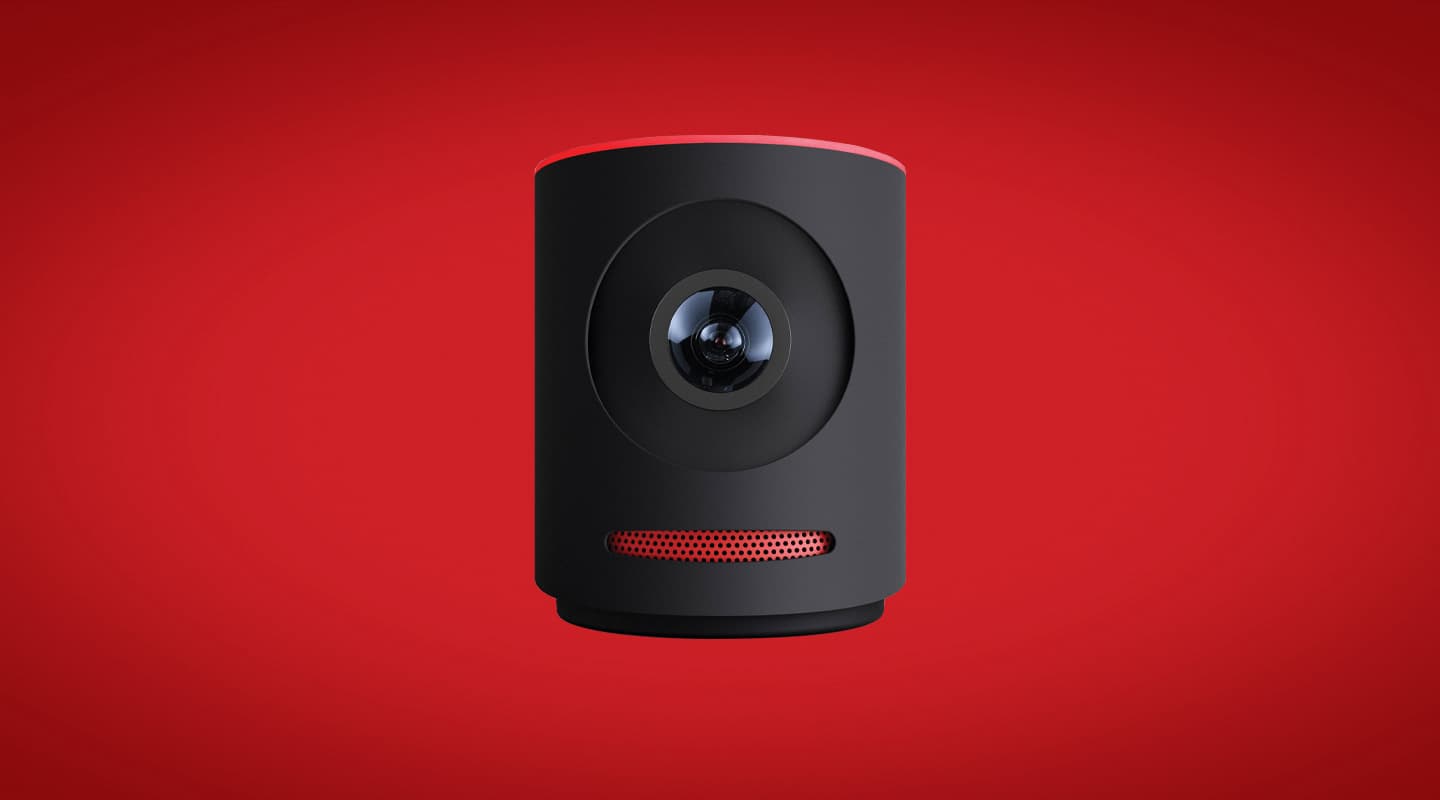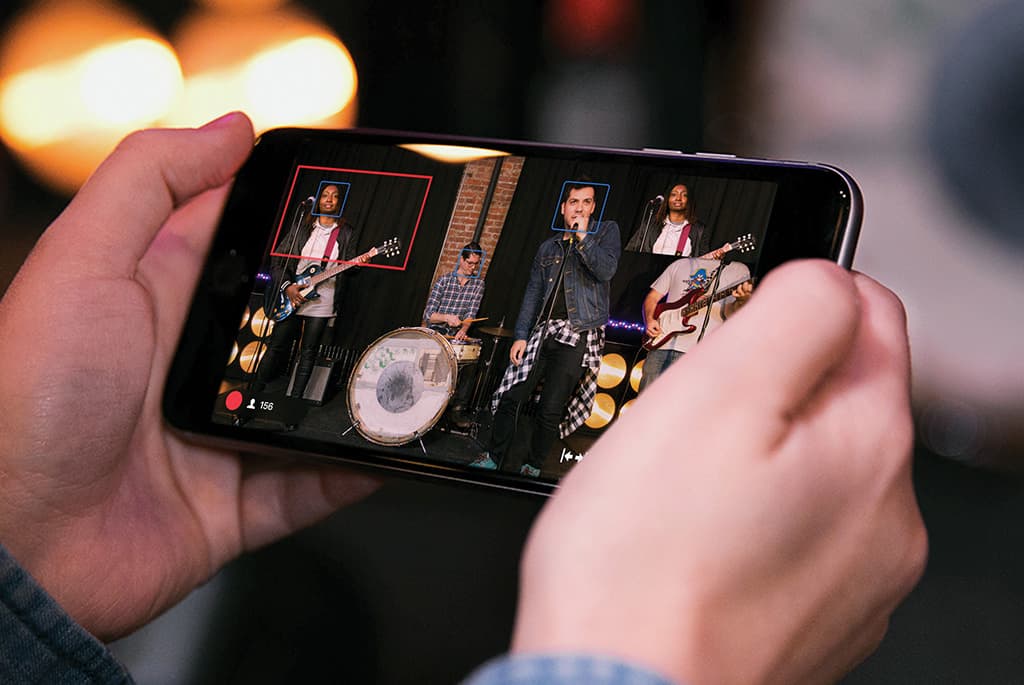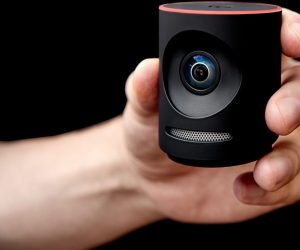
Mevo Live Event Camera
LiveStream’s pocket TV Studio.
Review:/ Andrew Bennett
‘This is truly amazing, a portable television studio! No wonder your president has to be an actor, he has to look good on television’. Fans of the 1985 hit Back to the Future would recognise that statement from the 1955 iteration of Doc Brown describing the JVC GR-C1, the first ‘all-in-one VHS Camcorder’ Marty brought with him from 1985.
One can only imagine what Doc Brown would have thought of Mevo!
Mevo truly is a device of the future, yet paradoxically feels like an old friend. I say ‘paradoxically’ because Mevo does something affordably and simply, that very few of us even considered a few years ago… yet, it feels like the product we’ve been waiting year for.
Looking somewhat like a mechanical extra from Monsters Inc, Mevo packs the sort of punch that belies the modestly-proportioned packaging. Measuring just shy of three inches high and with a diameter of two inches, the Mevo comprises a 4K camera, microphone array, 1200mAH Li-Ion battery, along with wi-fi and Bluetooth connectivity, all inside its tiny footprint. One up on Marty’s VHS Camcorder, it can live stream using either the streaming service LiveStream or Facebook Live. Doc would be proud, Mevo literally is a portable television studio.
FACE OF MEVO
The Mevo has but one button: the top of the unit functions as a power button, everything else is driven via the Mevo App on an iOS device. (At the time of writing the minimum requirements stated: an iPhone 5S with iOS9 or higher.) From the app you have full control over the camera, the angles (explored below), camera settings, network settings, streaming settings etc. It is intuitive, so easy to use, in fact, that a small child could be taking selfies, calling grandma and cutting between camera angles before they can walk.
CAMERA ANGLES
Okay, here’s the Mevo pitch: our brains get bored quickly, especially with the same old, locked-off camera angle. What if there was a way to fake multiple camera angles from a single camera? Mevo pulls off this party trick. How? By building it around a 4K Sony Sensor with a 150° lens, then by providing software that easily allows cropping into multiple ‘pseudo’ camera angles. Sure, the laws of physics dictate that one camera can’t produce a front and side-on shot simultaneously, however, it is possible to cut to various parts of a single scene and give the illusion of multiple shots. If you’re conducting a product demo and want to cut from a wide shot of the person presenting the product to a closer view of the product itself, it’s possible. Want to have a couple of talking heads in an interview style and cut between the two participants? That’s possible too. All of this editing is achieved through the app. The camera can stay fixed on a single stand and give the illusion of a larger production.
MORE INFO
Corsair Solutions: (03) 9005 9861 or corsairsolutions.com.au

APP: NICE GESTURE
The app, too, is very intuitive. It employs the same basic iOS gesture control — tapping, dragging and pinching — we’re all naturally familiar with. The app presents you with a ‘wide’ perspective, showing you everything in the camera’s purview, then upon pinching and dragging, a smaller blue rectangle describes the dimensions of the proposed crop. There is a handy floating ‘program’ screen that shows you exactly what is going out to broadcast.
Camera angles can be preset, it’s just a matter of tapping and zooming into the angle you want to use from within the app, then tapping and holding for a second or so, this creates a ‘static shot’. You can then cut between these ‘static shots’ by simply tapping on them in the app, thus simulating cutting between different cameras. There’s always the handy, fallback ‘Go Wide’ button, just in case the situation calls for the widest shot possible. I considered it as my ‘panic button’ just in case someone moved outside my ‘static shot’ presets.
CALLING THE SHOTS
It is also possible to ‘pan’ and ‘tilt’ around the scene.There are two modes to work with and they’re a bit tricky to master: the first is using a single finger on the screen and tapping and dragging around. This doesn’t perform the pan/tilt move until after you lift your finger off the screen. Mostly a Mevo production is unscripted — a webinar or presentation — so there’s some guesswork involved with the single-finger approach — which part of the frame is my presenter going to end up? However, I discovered that if you use a two-finger gesture on the screen and perform the same action, it does it in real time.
NO DIRECTOR, NO PROBLEMS
For those times when it’s just a one person show, sometimes it’s handy to have a third hand. Mevo packs built-in people detection and movement tracking, and there is the option to enable an ‘auto director’ style mode where the Mevo will follow ‘where the action is’. This is handy when manpower is limited. I found during my tests that the optimum distance between the subject and the Mevo for this to successfully track is between 1m and 3.5m. Any more and the error rate increases. Also note: you’re working with Mevo’s ‘face tracking’ technology, not ear tracking technology. When the subject turns away for a period of time it can confuse Mevo even if the presenter is talking. This feature works at its best when subjects are talking at the camera — which is going to be most of the time, if you want to retain an audience.
COOL DESIGN
The industrial design team did a lovely job of making the Mevo look ‘cool’. It feels solid, yet is soft to touch. The magnetic ‘base’ can be removed to fit the Boost option. Both the base and Boost have an intelligent three-thread insert, that allows mounting to either a ¼-20 standard tripod thread or 3/8-16 microphone or light stand thread, or 5/8-27 microphone stand thread.

New Features Released at NAB
A new beta Mevo Android App (v1.0b1): Mevo was previously only available on iOS. There’s now a first version of an Android App in beta. Full release in the Google Play app store is expected by the end of (northern) Summer 2017.
A beta release of the new iOS Mevo App (v1.5b1): with new features is now also available for download. App store releases of these features is scheduled for (northern) Summer 2017.
YouTube Live (beta): Mevo support for YouTube Live. Now you can use Mevo to stream to Livestream, Facebook Live, YouTube, and Twitter/Periscope.
4K Recording (beta): Mevo was a 720p camera, but now via a free app and software update you can now record in 4K 30fps 50Mbps on your Mevo SD card. Other bitrate options and 1080p resolution are also available.
1080p Streaming (beta): Previously locked to 720p, you can now stream in 1080p to supporting platforms (for now, Livestream and YouTube).
Advanced Facebook Live settings (beta): now support for continuous streaming options, scheduled livestreams to Facebook pages, geographic location tags, adding friends via tags, and advanced video targeting.
BOOST
In some situations the 1200mAH Li-Ion battery just isn’t large enough for the job. Other times, when 4G or wi-fi reception is patchy, you’ll want to plumb straight into the network. Mevo has both situations covered with the ‘Boost’ accessory. The battery has an extended capacity of 12,000mAH, enough for ’10 hours of filming’ according to the Mevo team. A neat Boost battery feature: you can hook up a USB charging cable for your iOS device and keep your device charged off the Boost, while it’s powering the Mevo camera.
The Ethernet connectivity works in an interesting manner. When the Mevo detects the ethernet cable, it can go into a ‘hotspot’ mode, so that an iOS device can talk to the Mevo to control it. However, it doesn’t appear to pass the internet through to the iOS device in this mode, and the app wasn’t able to stream video out to a third party. The Mevo app recommended I connected to a wi-fi network on the same network as the ethernet. I tried that and was then able to stream the video. According to the Mevo team, it’s possible to buy ~$100 in Apple dongles to support Ethernet onto the iOS device which would then allow for both the Mevo and the iPhone to be connected via ethernet and support streaming. The Boost does support streaming by the iPhone’s 3G/4G network while in Hotspot mode (but this removes the benefit of having the ethernet cable in the first place).
THE IMPORTANCE OF AUDIO
George Lucas is often quoted saying ‘The sound and music are 50% of the entertainment in a movie’. The Mevo is primarily a video device, but audio is also very important to the final product. While the Mevo has a built-in microphone array, it won’t work magic and sound like a shotgun mic/boom operator combo. However, the Mevo does support external audio in a number of ways. The first is by using a combination of dongles and spaghetti cables to get audio straight into the iOS device. Then inside of the Mevo app, there is a setting to use ‘iOS Audio’ instead of the Mevo Audio. The Boost also provides a USB port (the same one I used to charge my iOS device), a handful of USB microphones and audio interfaces can be connected via this USB port and an entire world of external audio options opens up. Check the help articles on the Mevo site for a list of supported interfaces.

STREAMING OPTIONS
Mevo is developed by LiveStream, the New York company founded in 2007 with a mission ‘to enable organisations to share experiences through live video, unlocking a world where every event is available live online.’ Naturally, the Mevo supports streaming over LiveStream, it also supports streaming via Facebook Live. The microSD slot allows for recording now and sharing later on whatever video platform you prefer. Videos are recorded at 720p resolution, in a standard MP4 format.
LAG
There is that great trick over the summer employed by many a cricket lover, but who doesn’t have the luxury of watching the match all day. They tune into the radio broadcast and listen to it while going about their day and have the TV on in one room on mute, if a wicket falls or Davey Warner hits a hapless offie into the carpark, it gives them just enough time to run to the TV, unmute it and see it play out in ‘real time’. It’s probably the only time that broadcast lag is a desirable feature.
A similar thing occurs with the Mevo: it has approximately a one-second lag between real-time action and what appears on screen; then anywhere from 5-15 seconds between what is seen on the iPhone screen and what is seen on Facebook Live. I don’t see this as a deal breaker, or even a problem, in the situations Mevo will find itself in. But worth knowing.
POCKET STUDIO
The beautifully designed product is truly a TV studio in your pocket. It’s ability to take your message and stream it to the world via LiveStream or Facebook Live was a foreign concept just a few years ago. Such a setup required expensive equipment and possibly an outside broadcast van. However, as amazing an offering as the Mevo is, I would say that it’s just one part of a larger system. For a successful production you still need to address lighting, audio and network connectivity, along with the talent in front of the camera.
This is not a device that’s going to replace large professional systems, and it’s not designed to. This is a device that’s designed to empower those who don’t have the resources for such complex systems. For professionals, the features may be limiting, but will purchase Mevo to get them out of a tight spot or for when budgets are limited. For others, Mevo is opening up an entirely new market, platform and audience just waiting to be explored.















RESPONSES